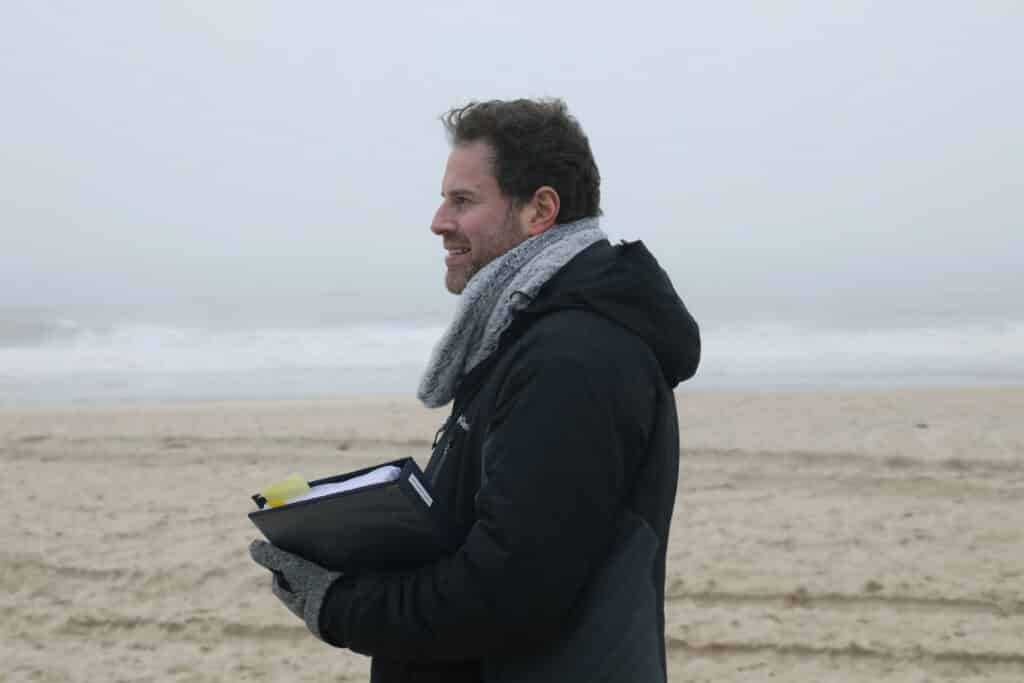So much has been written, filmed and discussed about the Hamptons, it can be hard for outsiders to discern the difference between true and false. There’s “The Hamptons” of much ballyhooed hype, and the much less ostentatious East End, where most of us actually exist.
Quietly and authentically separating fact from fiction is “The Artist’s Wife,” an emotionally complex film that comes alive as a layered yet subtle slice-of-life that many East End filmgoers will find entertaining and relatable.
Written and directed by Tom Dolby and starring Lena Olin and Bruce Dern, the film —about an obeisant wife who has put her career on hold in service to that of her celebrated artist husband — strikes the perfect balance between routine reality and respectful homage of place, plot and character. Loosely based on Dolby’s own experiences, the movie goes behind closed doors and deep into the usually unseen domestic life of a long-married couple.
The former Wainscott resident says that the film was inspired by the Hamptons, the local landscape and some of the most notable art-world denizens who made their lives here.
“From the house, to the studio and all the local establishments and spaces, I wanted the locations to be ingrained into and inform the characters,” he says. “That authenticity of place is incredibly important.”
In a broader sense, “The Artist’s Wife” is also a familiar story, and one that will immediately draw comparisons to the lives of notable East End artists, such as Lee Krasner and her spouse, Jackson Pollock and Elaine de Kooning and her husband, Willem de Kooning.
“It’s a tribute to these women, a contemporary imagining of the journey of the stronger woman behind the man — and what happens when the relationship begins to crumble due to circumstances beyond either person’s control, “says Dolby.
Intimate, credible and quite moving, the 90-minute feature is a rare gift to the actors and audience, due to its believability.
“That’s why I took the movie, the insightfulness of the writer,” says Dern. “I like that fact that he was trying to capture something from his soul and his private life.”
Olin agrees.
“I was so moved by the story, and by Claire’s [her name in the film] character. You really feel that Tom put his heart into this,” she says. “And as a person who is always striving for authenticity and intimacy in my work, it’s wonderful to have experienced it with this film.”
From the spot-on performances to the brilliant location choices (including a big, black behemoth of a modern house on East Hollow Road in East Hampton, a Pollock-inspired barn studio, and pivotal scenes shot at the beach, Three Mile Harbor, Guild Hall, Golden Eagle and White’s Apothecary, to name a few) and little-seen deep winter scenery, the feature film captures the natural essence of the Hamptons and the people who call it home.

Olin, who lives in New York and is a frequent visitor to the East End, notes that the locations in the film are integral to the story.
“The setting really informs the character,” says the Academy Award nominee. “And the house was a huge part of the story, down to the artwork and the form of the structure itself.”
The actual residence depicted in the story had been owned by friends of the director at one time, he reports. It was what he saw in his mind’s eye as he was writing the film.
That personal selection and setting is key to the telling of the story, says Dern.
“It plays a part in two of the most revealing scenes,” he reports of the home. “One, when I throw the painting out of my house and later when the house is all torn apart and I’m flinging the stuffing from the furniture at the painting. That shows that I forgot how to paint but I’m doing all I know how to do, which is putting the stuff of my life on the canvas.”
Being truly present in such dramatic beats is what makes for such a credible performance, according to his co-star.
“Bruce has this very different and brave way of throwing himself into his scenes,” she says of the Academy Award-winning actor. “It’s so powerful and moving, a rare thing to see onscreen.”
On the face of it, Dern’s approach to his work is uncomplicated, though what shines through is anything but simple.
“Don’t perform. Don’t act. Just be,” he says of turning the what’s on the page into reality. “It’s not about showing, it’s about letting the viewer find it on their own.”
“The Artist’s Wife” premiered at the HIFF this past October. It will be screened in theaters this summer.









![In the fine art world, you will be delighted to discover @brendanhjohnston, a young artist with an old master approach. While many credit “talent,” Johnston emphasizes the importance of training. The renaissance approach is to master drawing, painting and sculpture from real life. [link in bio]](https://hamptonsrealestateshowcase.com/wp-content/uploads/sb-instagram-feed-images/488712809_18502145848030135_7241807570408860772_nfull.webp)
![Experience the best of both worlds with exclusive beachfront and boating access in this exceptional Southampton property. Set in a sought-after waterfront community, 21 East Shore Drive offers an impressive 111± ft. of private sandy beach and protected bulkhead, with water on both sides. Represented by @angelaboyerstump of @sothebysrealty. [link in bio]](https://hamptonsrealestateshowcase.com/wp-content/uploads/sb-instagram-feed-images/488569507_18501957808030135_1349506531287636033_nfull.webp)
![First time ever on the market, this is a unique opportunity to own in the desirable and charming Historic District in the Village of Sag Harbor. 63 Glover Street is considered the most sought-after in the Village, boasting 100± ft. of panoramic water frontage, half bulkheaded, on Sag Harbor Cove with a deep water dock and a separate living cottage. Represented by @thebestofthehamptons of @brownharrisstevens. [link in bio]](https://hamptonsrealestateshowcase.com/wp-content/uploads/sb-instagram-feed-images/488065237_18501743197030135_1061235731645102537_nfull.webp)
![Drawing inspiration from the Greek Revival style of architecture, 7 Somers Place was developed by Sag Harbor master builder, Robert Tortora. The gracious living room with mantled masonry fireplace and elevated ceilings flows to the spacious dining room and custom light-filled kitchen. Represented by @thechrisritchey and Kim Hovey of @compass. [link in bio]](https://hamptonsrealestateshowcase.com/wp-content/uploads/sb-instagram-feed-images/488012730_18501545716030135_2576407923807360973_nfull.webp)
![Elegance and intelligence abound at this waterfront masterpiece with 8,065± sq ft, 7 bedrooms and 8.5 baths. 101 Jessup Lane boasts a sweeping double stairway entry hallway, 7 romantic fireplaces, a large gathering room, formal dining room, billiard room, and exercise room with sauna. Represented by @rydbergkent of @douglaselliman. [link in bio]](https://hamptonsrealestateshowcase.com/wp-content/uploads/sb-instagram-feed-images/486626595_18501344173030135_6414454892538890571_nfull.webp)
![Discover fabulous floral finds and nature-inspired treasures to bring beauty and charm to your life. Whether you’re adding a touch of nature to your home or finding the perfect gift, these blooming delights are sure to brighten your day! [link in bio]](https://hamptonsrealestateshowcase.com/wp-content/uploads/sb-instagram-feed-images/487711988_18500839267030135_4881948075500906108_nfull.webp)
![Spring, of course, leads inexorably into another summer season here in the Hamptons. According to agents we spoke to, demand is quite strong this year for rentals. A quality medium-priced property, well presented with amenities, is eagerly sought-after. Publicly listed rentals range from a high of $2.5 million, Memorial Day to Labor Day, on Cobb Lane in Water Mill, with quite a few more $1 million plus rentals than usual. [link in bio]](https://hamptonsrealestateshowcase.com/wp-content/uploads/sb-instagram-feed-images/486541532_18500603206030135_1827695170316201968_nfull.webp)
![Perched atop the dunes at Louse Point sits a picturesque house, perfect for enjoying all seasons that East Hampton has to offer. Situated on three quarters of an acre with almost 360 degree views of Gardiner’s Bay and Accabonac Harbor, 86 & 88 Louse Point are truly unique. Represented by @petrieteam of @compass. [link in bio]](https://hamptonsrealestateshowcase.com/wp-content/uploads/sb-instagram-feed-images/486615712_18500408650030135_1498783920053065135_nfull.webp)
